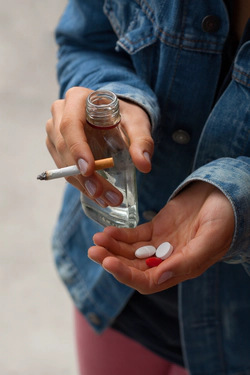Addiction Treatment Should Focus on Individuals, Not Drugs of Choice
When addiction response efforts focus on just one drug (opioids) as America’s main drug problem, those responses miss the mark because most addicts use multiple drugs.

A fair amount of research and analysis towards addressing America’s addiction crisis has been invested in examining the opioid addiction epidemic and how the U.S. might respond to it. Unfortunately, that work has primarily sought to understand the drug side of the epidemic rather than the human side of addiction. Given that new research shows that 75% of addicts use more than one drug, taking a human-focused approach to addiction might give policymakers and public health officials a better shot at overcoming all forms of drug addiction.
No Single Drug Is the Culprit
The sheer number of addicts using more than one drug is alarming. According to one research paper published in the Journal of Substance Abuse Treatment, some 75% of addicts list more than one drug when asked what drug they use.1
That has devastating consequences on addicts, as the more substances they use, the more likely they are to experience life-threatening health crises, long-term harm, and overdoses. To that point, another paper showed that at least half of all fatal drug overdoses involve an addict who overdosed on a cocktail of drugs, not just one drug.2
Since the War on Drugs began some 50 years ago, the main theme of America’s response to drug addiction has been to tackle and criminalize drug abuse from a supply-side approach, seeking to block and arrest illicit drug producers, traffickers, dealers, and users. Every time a new drug type or trend cropped up, the response was to criminalize those involved with it. From the wave of cannabis and hallucinogen experimentation in the 1970s to the crack cocaine epidemic of the 1980s, the heroin crisis of the 1990s, the pharmaceutical opioid epidemic of the 2000s, and the spread of synthetic opioids occurring today, the response to drug abuse has always been to focus on the drugs being used, not the humans using them.
Perhaps the new findings that show most addicts use more than one drug will convince U.S. policymakers that addressing the drug problem must come from a demand-side approach, not a supply-side approach.
In short, it’s time to focus on the people using the drugs, not the drugs they’re using.
Unpacking Polysubstance Abuse

Polysubstance abuse means a drug user is addicted to multiple drugs. They are not “just” a heroin addict or “just” an alcohol addict. They are addicted to multiple drugs, which means treating them will involve helping them overcome all their drug habits, not just one of them. It means that the individual’s underlying problems that compel them to seek drugs are more crucial to address than the drugs, as the drugs are just a vehicle by which the individual escapes their life crises.
Many addiction researchers are finding that polysubstance abuse is the norm. This observation breaks with the traditional supply-side response rhetoric that says, “If only we can stop x drug from coming into the country, we’ll have addressed the addiction epidemic.” Contrary to that rhetoric, it seems drug addiction cannot be solved by simply halting the supply of a certain drug, not if addicts find other drugs (or multiple types of drugs) to use when their preferred supply runs dry.
Researchers out of Oregon who had their findings published in the Journal of Substance Abuse Treatment (cited earlier) spoke to this point. Quoting lead study author Caroline King, M.P.H., a health systems researcher and current M.D./Ph.D. student in the OHSU School of Medicine’s biomedical engineering program, “We found that polysubstance use is the norm. This is important because we may need to offer additional support to patients using multiple drugs. If someone with opioid use disorder also uses alcohol or methamphetamines, we miss caring for the whole person by focusing only on their opioid use… Understanding the complexity of people’s substance use patterns is really important to honoring their experience and developing systems that support their needs.”3
“If someone with opioid use disorder also uses alcohol or methamphetamines, we miss caring for the whole person by focusing only on their opioid use…”
Across the country, public health experts are beginning to see that American drug abuse trends are shifting. For example, another detailed research paper unpacks the recent wave of opioid overdoses in Oregon. That paper concluded that most drug overdoses in that state involved more than one drug and that it might be the polysubstance nature of drug abuse in Oregon that led to a spike in fatal overdoses.4
According to the Centers for Disease Control and Prevention, at least 250 Americans lose their lives to drug overdoses daily, the equivalent of a Boeing 747 airplane going down and killing everyone on board every day. According to the CDC, at least 50% of all fatal overdoses involve addicts who were using multiple drugs at the time of death.5
Even if addicts don’t die due to mixing drugs, the life-altering health consequences can be extremely harsh. Mixing stimulants with other drugs produce effects like:
- Stroke
- Heart attack
- Brain injury
- Liver damage
- Troubled breathing
- Nausea and vomiting
- Increased body temperature
- Chest pain, seizures, and tremors
Mixing depressants with other drugs produce effects like:
- Overdose
- Weak pulse
- Passing out
- Slow breathing
- Damage to the brain and organs
- An altered mental state and extreme disorientation
Public health officials at the CDC also warn that mixing alcohol with other drugs, especially prescription drugs, is extremely harmful. The depressant effect of alcohol can be amplified when used alongside other drugs, and the effects can be catastrophic.
Addiction Treatment Must Focus on the Person, Not the Drugs They’re Using
It’s important to understand drug use trends and to know what types of drugs are becoming popular among users. But when it comes to treatment, rehab centers will succeed in rehabilitating addicts to the extent that their programs focus on the person in recovery, not the drugs they used. The road out for addicts should involve a highly personalized approach to recovery, one that takes the individual’s experiences and habits, challenges, and underlying issues into account, not just the drugs they use.
Sources:
-
JSAT. “Patterns of substance use before and after hospitalization among patients seen by an inpatient addiction consult service: A latent transition analysis.” Journal of Substance Abuse Treatment, 2020. journalofsubstanceabusetreatment.com ↩︎
-
NIH. “The Polysubstance Overdose-Death Crisis.” National Institutes of Health, 2020. ncbi.nlm.nih.gov ↩︎
-
Science Daily. “Look beyond opioids to solve national substance use epidemic.” Science Daily, 2020. sciencedaily.com ↩︎
-
OHA. “Opioids and the Ongoing Drug Overdose Crisis in Oregon.” Oregon Health Authority, 2022. dhsoha.state.or.us ↩︎
-
CDC. “Polysubstance Use Facts.” Centers for Disease Control and Prevention, 2022. cdc.gov ↩︎







 ®
®